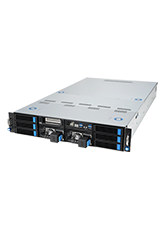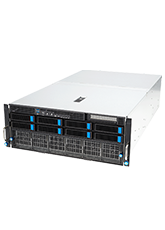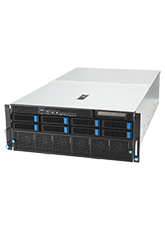
Servers - Training
3XS EGX Rendering Servers - 4x GPU
These custom-built GPU-accelerated servers are optimised for rendering workloads and are based on the latest PCIe NVIDIA GPU accelerators. The following systems are fully configurable to meet your requirements, if you can't see the specification you would like please call 01204 474747 or email [email protected].
3XS EGX N4-1E-2U
- Up to 4x PCIe NVIDIA GPUs
- 1x AMD EPYC 9004/9005 CPU - up to 128C/256T
- Up to 1.5TB 12-channel DDR5 5600 ECC Registered
- 2x 2.5" / 2x 3.5"
- Redundant 2600W PSUs
- 2U 19in rack server
- 3 Year Premium Warranty
This powerful Deep Learning training system is a 2U rackmount server capable of supporting up to 4 PCIe dual-slot NVIDIA GPU accelerators with a host CPU from the AMD EPYC 9004/9005 processor series with up to 128 cores and 1.5TB of 12-channel DDR5 memory.
3XS EGX N4-1E-4U
- Up to 4x PCIe NVIDIA GPUs
- 1x AMD EPYC 9004/9005 CPU - up to 128C/256T
- Up to 1.5TB 12-channel DDR5 5600 ECC Registered
- 12x 2.5"
- Redundant 2600W PSUs
- 4U 19in rack server
- 3 Year Premium Warranty
The 3XS Deep Learning EGX N4-1E-4U is a high performance workstation for deep learning, using the power of up to four NVIDIA GPU accelerators. The host CPU is from the AMD EPYC 9004/9005 processor series with up to 128 cores and supports up to 1.5TB of ECC DDR5 memory. The chassis supports multiple SSDs for your projects and is pre-configured with Ubuntu 22.04 plus NVIDIA Docker.
3XS EGX N4-2X-2U
- Up to 4x PCIe NVIDIA GPUs
- 2x Intel 4th/5th Gen Xeon CPUs - up to 128C/256T
- Up to 2TB 8-channel DDR5 5600 ECC Registered
- 2x 2.5" / 2x 3.5"
- Redundant 2600W PSUs
- 2U 19in rack server
- 3 Year Premium Warranty
This powerful Deep Learning training system is a 2U rackmount server capable of supporting up to 4 PCIe dual-slot NVIDIA GPU accelerators with host CPUs from the Intel 4th/5th Gen Xeon processor series with up to 64 cores per CPU and 2TB of 8-channel DDR5 memory.
3XS EGX Rendering Servers - 8x GPU
These custom-built GPU-accelerated servers are optimised for rendering workloads and are based on the latest PCIe NVIDIA GPU accelerators. The following systems are fully configurable to meet your requirements, if you can't see the specification you would like please call 01204 474747 or email [email protected].
3XS EGX N10-2E-5U
- Up to 10x NVIDIA RTX Accelerators
- 2x AMD EPYC 9004/9005 CPU - up to 128C/256T
- Up to 3TB 12-channel DDR5 5600 ECC Registered
- 4x 2.5"
- Redundant 1300W PSUs
- 5U 19in rack server
- 3 Year Premium Warranty
The 3XS EGX N10-2E-5U is a high performance workstation for deep learning, using the power of up to ten NVIDIA GPU accelerators. The host CPUs are from the AMD EPYC 9004/9005 processor series with up to 128 cores per CPU and supports up to 1.5TB of RDIMM DDR5 memory. The chassis supports multiple SSDs and HDDs for your projects and is pre-configured with Ubuntu 22.04 plus NVIDIA Docker.
3XS EGX N8-2E-4U
- Up to 8x PCIe NVIDIA GPUs
- 2x AMD EPYC 9004 CPUs - up to 128C/256T
- Up to 3TB 12-channel DDR5 5600 ECC Registered
- 8x 3.5"
- Redundant 3000W PSUs
- 4U 19in rack server
- 3 Year Premium Warranty
This powerful Deep Learning training system is a 4U rackmount server capable of supporting up to 8 PCIe dual-slot NVIDIA GPU accelerators, with two host CPUs from the AMD EPYC 9004 processor series with up to 128 cores per processor and 3TB of 12-channel DDR5 memory.
3XS EGX N8-2X-4U
- Up to 8x PCIe NVIDIA GPUs
- 2x Intel 4th/5th Gen Xeon CPUs - up to 128C/256T
- Up to 4TB 8-channel DDR5 5600 ECC Registered
- 8x 3.5"
- Redundant 3000W PSUs
- 4U 19in rack server
- 3 Year Premium Warranty
This powerful Deep Learning training system is a 4U rackmount server capable of supporting up to 8x PCIe dual-slot NVIDIA GPU accelerators, plus a pair of powerful Intel 4th/5th Gen Xeon Sapphire Rapids processors with up 64 cores per processor, plus up to 4TB of 8-channel DDR5 memory.
3XS MGX Deep Learning Training Servers - 8x GPU
These custom-built deep learning servers are optimised for training AI algorithms and are based on NVIDIA H200 or RTX 6000 PRO GPU accelerators. The following systems are fully configurable to meet your requirements, if you can't see the specification you would like please call 01204 474747 or email [email protected].
3XS MGX N8-2E-4U
- Up to 8x NVIDIA RTX PRO 6000 or H200 GPUs
- 2x AMD EPYC 9005 CPUs - up to 192C/384T
- Up to 3TB 12-channel DDR5 5600 ECC Registered
- 8x 2.5"
- Redundant 3200W PSUs
- 4U 19in rack server
- 3 Year Premium Warranty
This powerful Deep Learning training system is a 4U rackmount server capable of supporting up to 8x NVIDIA H200 or RTX PRO 6000 GPUs, with two host CPUs from the AMD EPYC 9005 processor series with up to 192 cores per processor and 3TB of 12-channel DDR5 memory.
3XS MGX N8-2X-4U
- Up to 8x NVIDIA RTX PRO 6000 or H200 GPUs
- 2x Intel Xeon 6 CPUs - up to 80C/160T
- Up to 4TB 8-channel DDR5 5600 ECC Registered
- 8x 2.5"
- Redundant 3200W PSUs
- 4U 19in rack server
- 3 Year Premium Warranty
This powerful Deep Learning training system is a 4U rackmount server capable of supporting up to 8x NVIDIA H200 or RTX PRO 6000 GPUs, with two host CPUs from the Xeon processor series with up to 80 cores per processor and 4TB of 8-channel DDR5 memory.
3XS HGX HPC Servers
These custom-built GPU-accelerated servers are optimised for HPC workloads and are based on the latest high-density SXM4 NVIDIA GPU accelerators. The following systems are fully configurable to meet your requirements, if you can't see the specification you would like please call 01204 474747 or email [email protected].
3XS HGX H200
- 8x NVLink 80GB NVIDIA H200 GPUs
- 2x Intel Xeon Platinum 8558 CPUs - up to 96C/192T
- 2TB 8-channel DDR5 ECC Registered
- 2x 1.92TB NVMe + 4x 3.84TB NVMe
- Redundant 3000W PSUs
- 7U 19in rack server
- 3 Year Premium Warranty
This ultra powerful Deep Learning training system is a 7U rackmount server equipped with 8x NVIDIA H200 GPU accelerators connected via NVLink for the ultimate performance. The system has two host Intel Xeon Platinum 8558 CPUs with a total of 96 cores and 2TB of 8-channel DDR5 memory. Also included is are 2x 1.92TB NVMe drive for the OS and 4x 3.84TB NVMe drives for data.
3XS HGX B200
- 8x NVLink 80GB NVIDIA B200 GPUs
- 2x Intel Xeon 6960P CPUs - up to 144C/288T
- 2TB 8-channel DDR5 ECC Registered
- 2x 960GB NVMe & 8x 3.84TB NVMe
- Redundant 5250W PSUs
- 10U 19in rack server
- 3 Year Premium Warranty
This ultra powerful Deep Learning training system is a 10U rackmount server equipped with 8x NVIDIA B200 GPU accelerators connected via NVLink for the ultimate performance. The system has two host Intel Xeon 6960P CPUs with a total of 72 cores and 2TB of 8-channel DDR5 memory. Also included is are 2x 960GB NVMe drive for the OS and 8x 3.84TB NVMe drives for data








